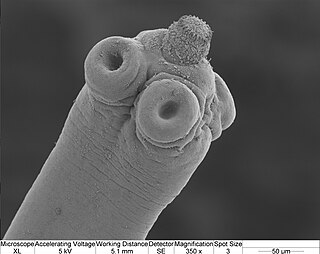| Microstoma | |
|---|---|
 | |
| Microstoma microstoma | |
| Scientific classification | |
| Kingdom: | |
| Phylum: | |
| Class: | |
| Order: | |
| Family: | |
| Genus: | Microstoma G. Cuvier, 1816 |
Microstoma is a genus of pencil smelt.
| Microstoma | |
|---|---|
 | |
| Microstoma microstoma | |
| Scientific classification | |
| Kingdom: | |
| Phylum: | |
| Class: | |
| Order: | |
| Family: | |
| Genus: | Microstoma G. Cuvier, 1816 |
Microstoma is a genus of pencil smelt.
There are currently 2 species in this genus:

Lorisidae is a family of strepsirrhine primates. The lorisids are all slim arboreal animals and comprise the lorises, pottos and angwantibos. Lorisids live in tropical, central Africa as well as in south and southeast Asia.

Loris is the common name for the strepsirrhine primates of the subfamily Lorinae in the family Lorisidae. Loris is one genus in this subfamily and includes the slender lorises, while Nycticebus is the genus containing the slow lorises.

Acrossocheilus is a genus of ray-finned fishes in the family Cyprinidae, native to freshwater in China, Taiwan, Laos, and Vietnam. They are fairly small, no more than 30 cm (1 ft) in standard length.

The Leptotyphlopidae are a family of snakes found in North America, South America, Africa and Asia. All are fossorial and adapted to burrowing, feeding on ants and termites. Two subfamilies are recognized.
The slender argentine, Microstoma microstoma, is a species of pencil smelt, found around the world in tropical and subtropical areas. This species grows to a length of 21 centimetres (8.3 in) TL. Its main food includes other fish, and its feces.
The weasel sharks are a family, the Hemigaleidae, of ground sharks found from the eastern Atlantic Ocean to the continental Indo-Pacific. They are found in shallow coastal waters to a depth of 100 m (330 ft).

The sicklefin weasel shark is an uncommon species of ground shark in the family Hemigaleidae. It is native to southern India, southern China, and parts of Southeast Asia, living in shallow waters down to a depth of 170 m (560 ft). This lightly built shark is characterized by its very short mouth, broad upper teeth with serrations only on the trailing edge, and strongly sickle-shaped fins with obvious white tips on the two dorsal fins. It is light grey or bronze in colour, often with small white blotches on its sides; it reaches a maximum known length of 1.1 m (3.6 ft).

Labeobarbus intermedius is an East African ray-finned fish species in the family Cyprinidae. Like the closely related yellowfish, it is hexaploid. A large species, the maximum recorded standard length is nearly 50 cm (20 in). This species has a subspecies named Labeobarbus intermedius intermedius.

Mecistops is a genus of crocodiles, the slender-snouted crocodiles, native to sub-Saharan Africa.
Ophryophryne is a genus of amphibian in the family Megophryidae from Southeast Asia. They are sometimes known as mountain toads.
Hemigaleus is a genus of weasel shark in the family Hemigaleidae. It is characterized by a rounded snout and short gill slits. The mouth is short and broadly arched; the teeth have very short cusps, without toothless spaces at the jaw midlines. The dorsal and pelvic fins, and the lower caudal lobe are strongly falchate. At one time or another, this genus has encompassed up to nine species, but most were eventually split off into other genera. Neogaleus Whitley, 1931 is a junior synonym of this genus.

Microstoma is a genus of cup fungi in the order Pezizales.

Hymenolepis microstoma, also known as the rodent tapeworm, is an intestinal dwelling parasite. Adult worms live in the bile duct and small intestines of mice and rats, and larvae metamorphose in the haemocoel of beetles. It belongs to the genus Hymenolepis; tapeworms that cause hymenolepiasis. H. microstoma is prevalent in rodents worldwide, but rarely infects humans.

The small-mouth righteye flounder is a flatfish of the family Pleuronectidae. It is a demersal fish that lives on saltwater bottoms from depths of 304 metres (997 ft). Its natural habitat is the tropical waters of the southwest Pacific. It can grow up to 10 centimetres (3.9 in) in length.
Neomyxine is a genus of hagfish found in the Pacific Ocean around New Zealand.
Bathylagichthys is a species of deep-sea smelts.

Siphamia is a genus of cardinalfishes native to the Indian and Pacific Ocean. Several of these species are commensal with various species of sea urchins.

Neobathyclupea is a genus of fish in the family Bathyclupeidae found in the Atlantic, Indian and Pacific Ocean.

Sargocentron microstoma, the fine-lined squirrelfish, slender squirrelfish or smallmouth squirrelfish, is a member of the family Holocentridae. It has a wide range throughout the Indo-Pacific from the Chagos Archipelago, Seychelles, and the Maldives to the Hawaiian Islands, Line Islands, and the Tuamotus Archipelago, north to the Ryukyu Islands and Bonin Islands, south to Austral Islands and throughout Micronesia. It lives near reefs usually at depths between 1–35 m (3.3–114.8 ft), but can be found as deep as 183 m (600 ft). During the day it hides in crevices, especially near Acropora and Pocillopora. It is a nocturnal predator, feeding on crustaceans, worms, and fishes. It can reach sizes of up to 20 cm (7.9 in) TL and has a venomous preopercle.